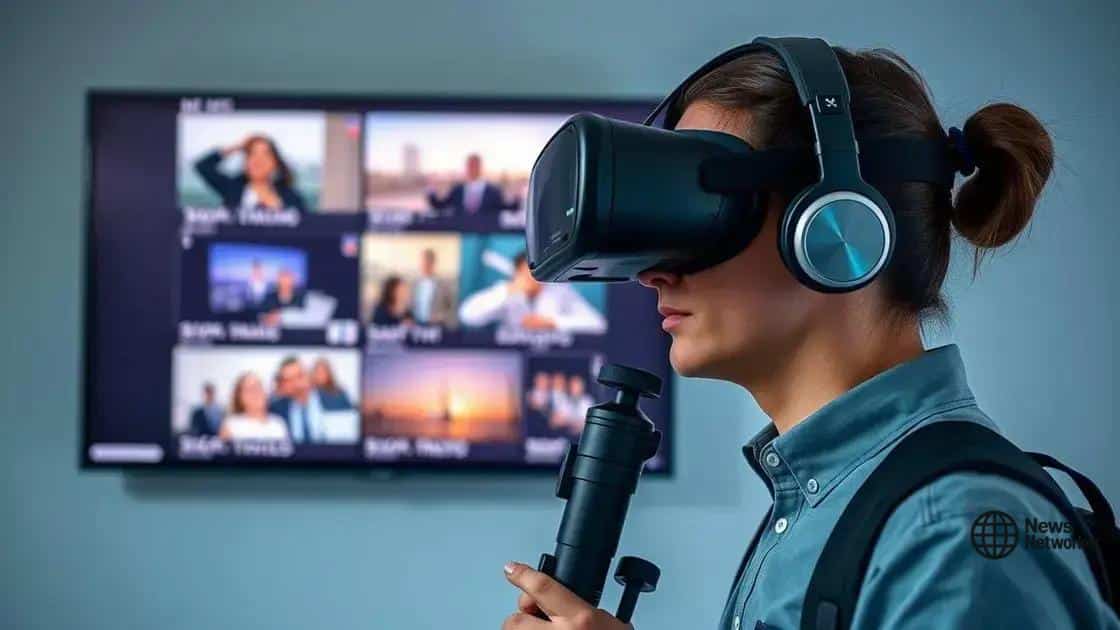Virtual reality in journalism: immersive storytelling techniques

Virtual reality in journalism enhances storytelling by creating immersive experiences that engage audiences, foster empathy, and provide deeper understanding of complex issues.
Virtual reality in journalism is changing the way stories are told. It offers a new dimension to exploring narratives that traditional media simply can’t match. Have you ever wondered how immersion influences your perspective on news?
Understanding virtual reality in journalism
Understanding virtual reality in journalism opens up exciting possibilities for how stories are told. This technology allows journalists to engage audiences like never before. By creating immersive experiences, users can feel as though they are part of the story, rather than just observers.
Key Concepts of Virtual Reality
Virtual reality (VR) is more than just a buzzword; it’s a transformative tool. It uses headsets and interactive technologies to place users in a 3D environment that simulates real-life situations. This makes stories more impactful by providing context and emotional depth.
- Immersion: Users feel like they are actually inside the story.
- Interactivity: Viewers can explore environments at their own pace.
- Empathy: Experiencing events from different perspectives can foster understanding.
As news evolves, so does storytelling. Virtual reality can help convey complex issues in a way that traditional methods cannot. For instance, imagine witnessing a natural disaster as if you were there. This immediacy can drive audiences to care deeply about reporting and the issues at hand.
Applications in Journalism
From covering breaking news to in-depth features, VR has multiple applications in journalism. For instance, organizations can create immersive reports on social issues to generate empathy and understanding. This method of storytelling can revolutionize the way news is perceived.
As journalists integrate VR technology into their work, they are not just telling stories; they are crafting experiences. By allowing audiences to walk through events, viewers connect emotionally with the subjects. This connection can influence public opinion and encourage action.
Benefits of immersive storytelling
The benefits of immersive storytelling in journalism are transformative. By using techniques like virtual reality, journalists can craft narratives that captivate audiences in a deeper way. This approach not only engages viewers but also influences their emotions and perspectives.
Enhanced Engagement
Immersive storytelling pulls the audience into the story. When viewers feel like they are part of the narrative, they are more likely to pay attention. This leads to higher levels of engagement than traditional storytelling methods.
- Increased viewer retention.
- Greater emotional connection to the story.
- Improved understanding of complex issues.
This method allows journalists to present information in a more compelling manner. For instance, a VR experience of a refugee camp can make an audience empathize with those living in such conditions, fostering a personal connection.
Fostering Empathy
One of the most powerful aspects of immersive storytelling is its ability to create empathy. By stepping into someone else’s shoes, viewers gain insights they may not have considered before. This can be particularly impactful in covering social issues.
When audiences experience events through the eyes of others, they develop a nuanced understanding of the challenges faced by different communities. This can drive change, as people become inspired to act after connecting emotionally.
Techniques for incorporating VR in reporting

Incorporating VR in reporting is not just about technology; it’s about creativity and storytelling. Journalists can use various techniques to bring their stories to life. Let’s explore some effective methods for integrating virtual reality into news reporting.
Creating Immersive Experiences
One of the primary techniques is to create immersive experiences that allow the audience to engage with the story. This can be done by:
- Using 360-degree video to capture real environments.
- Creating interactive elements where users can explore different angles.
- Utilizing audio to enhance the sense of presence.
These techniques help viewers feel as though they are in the midst of the action, making the story more impactful and memorable.
Employing Narrative Techniques
Another technique is the use of narrative storytelling in a VR environment. Here are some strategies to consider:
- Using personal stories to connect with the audience emotionally.
- Structuring the VR experience like a journey, guiding viewers through different scenes.
- Incorporating visuals and text to convey information without overwhelming the viewer.
Narrative techniques are crucial to maintaining engagement while delivering important information.
Additionally, collaboration with developers can enhance the quality of VR content. Journalists should work closely with tech experts to ensure that the VR experience is seamless and effective. This partnership can result in innovative storytelling techniques that make use of the latest technology.
As more journalists adopt these techniques, the potential for VR in reporting will continue to grow, opening up exciting possibilities for the future of news.
Case studies of VR in news stories
Case studies of VR in news stories showcase how this technology can transform the way we perceive and understand current events. By looking at specific examples, we can see the unique benefits and innovations that arise when journalism integrates virtual reality.
Exploring Key Examples
One prominent case is the New York Times, which featured VR experiences in its reporting. They produced a piece about the Syrian refugee crisis that allowed viewers to walk through a refugee camp. This immersive experience helped audiences feel the harsh realities faced by these individuals, fostering empathy and understanding.
- Real-life scenarios are brought to the forefront.
- Users can experience difficult situations firsthand.
- Enhanced emotional connections to global issues.
Another impactful example is The Guardian, which created a VR piece on climate change. This story allowed viewers to explore environments threatened by rising sea levels. Such interactive storytelling engages viewers more deeply than traditional articles or videos.
Impact on Awareness and Action
These case studies demonstrate that VR can raise awareness of critical global issues. When people experience stories through immersive technology, they are often moved to take action. For instance, those who viewed the refugee VR experience were more likely to support humanitarian efforts.
Furthermore, organizations can reach new audiences through compelling storytelling. VR not only informs but also creates a call to action. Journalism that engages emotions can lead to greater advocacy and involvement in important causes.
In general, the use of VR in news stories is still evolving, but these early examples show great promise. Journalists and news organizations are learning how to leverage this technology for storytelling that resonates with viewers on a personal level. As it matures, we can expect even more innovative applications that challenge the conventional boundaries of journalism.
Future trends in virtual reality journalism
Future trends in virtual reality journalism promise to reshape how stories are told and consumed. As technology evolves, journalists are finding innovative ways to engage their audiences. The adoption of VR is becoming more mainstream, which will continue to change the landscape of news reporting.
Increased Accessibility
One key trend is the increased accessibility of VR technology. As costs decrease and more platforms become available, more news outlets will be able to create immersive content. This shift will lead to a broader reach, allowing diverse audiences to experience stories in new ways.
- Greater use of affordable VR equipment by journalists.
- More VR storytelling workshops for aspiring reporters.
- Online platforms for sharing and viewing VR content.
With these advancements, even smaller news organizations can produce high-quality VR pieces, enriching the media landscape.
Enhanced Interactivity
Another trend is enhanced interactivity within VR experiences. Viewers will not only observe stories but interact with elements within the narratives. This engagement can lead to:
- Greater understanding of complex issues.
- Personalized experiences based on viewer choices.
- Real-time data integration during reporting.
By allowing people to take part in decisions within the story, journalism will create a more personal connection with the audience.
Furthermore, the integration of storytelling with emerging technologies like artificial intelligence will enhance the storytelling process. AI can help tailor content to audiences, making each experience more relevant. This approach allows journalists to focus on creativity while leveraging technology for better outcomes.
Overall, the future of virtual reality journalism holds enormous potential. As more organizations embrace these trends, the medium will continue to evolve. Audiences can look forward to richer, more immersive stories that enhance their understanding of the world around them.
FAQ – Frequently Asked Questions about Virtual Reality in Journalism
What are the main benefits of using VR in journalism?
The main benefits of using VR in journalism include enhanced engagement, increased empathy, and the ability to present stories in more immersive ways.
How can VR technology improve audience understanding?
VR technology allows audiences to experience events from different perspectives, which can lead to a deeper understanding of complex issues.
Is VR accessibility improving for news organizations?
Yes, as technology advances and costs decrease, more news organizations are able to produce and share VR content, making it more accessible.
What role will interactivity play in the future of journalism?
Interactivity will allow viewers to engage with stories on a personal level, making the news experience more relevant and impactful.





